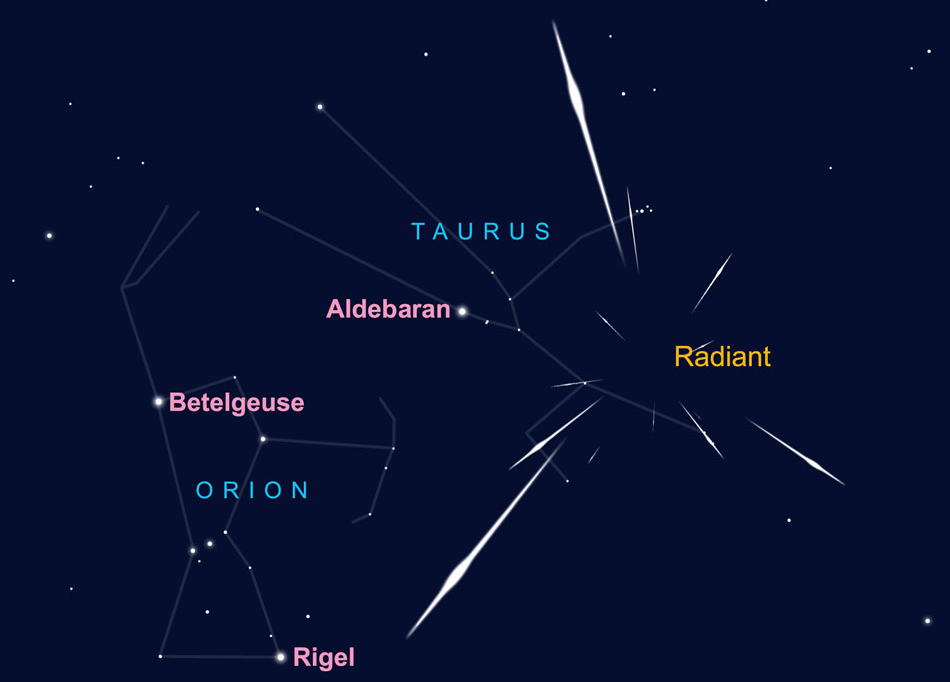Image source: Stargazing Mumbai
This Month’s Meteor Showers
God bless our many military personnel as we observe Veteran’s Day across the nation this week. Thanks to each one of the successive generations who have served ‘we the people’ for so long. Most of my generation had a parent who served in World War II or in Korea. Many of my generation were drafted right out of high school and served in Vietnam without much appreciation until the past decade. Without the men and women who served this nation from its pre-beginning through today, we, not to mention millions of others across the globe, would not be able to enjoy the blessings of liberty that we have enjoyed for almost 250 years. And if you wonder why I bring that up, it is those 50 stars in the flag that have grown out of the original 13. I can connect almost anything to astronomy.
So, what is going on somewhere out there? Plenty. This month brings two meteor showers, the Taurids, which peak on the 13th and the Leonids, which peak on the 17th. Of course, the phase of the Moon and probable clouds and for certain, light pollution, will have an effect on how many meteorites we actually are able to glimpse; we can still be anxiously hoping to have a spectacular one streak across our field of view. A dark observing site with a clear view of the southern sky will be the essential requirement. And since the peaks are during the week there is always the factor of getting up to go to work after staring at the sky after midnight in hopes for a few flashes of a meteor streaking through the sky.
The Taurids appear to radiate from the V shape of Taurus the Bull that will be emerging from the eastern horizon just before Orion does. Once it is well into the sky then the possible scant and faint meteors may be spotted. The Leonids will seem to appear from Leo the Lion that follows after Orion the Hunter.
Meteors are bits of comets or asteroids that have passed through our solar system leaving a trail of dust and debris suspended in their paths. Imagine how it is to drive to Port Isabel via Highway 4 in a sandstorm and you get the picture. If a meteoroid enters our atmosphere it is called a meteor as it gives off its light from the and if a meteor hits Earth, then it is considered a meteorite. https://leonid.arc.nasa.gov/meteor.html is a great source of real information about the differences.
Perhaps you have darker skies where you live, in which case you may set up your favorite telescope and explore the northern sky. I know I focus too often on the southern sky constellations so in this column lets make a change. With Ursae Minoris, with Polaris in its tail in the eyepiece, there is a multiple star system you might enjoy exploring. Our North star is very close to the North Celestial Pole and although the uninitiated usually think the North Star is an exceptionally bright star, it is not. At 2nd magnitude it is 447 light years from Earth and not a spectacular star at all, however vital it is to navigation. A triple star group, each star has a special designation and color as well as magnitude. If you know a bit of the Greek alphabet then you will definitely appreciate the designation of Polaris A as alpha. It has been classified as a Cepheid variable star because its brightness changes over a four-day period, although the change is only discernable with a telescope. It has a close companion star that takes almost thirty years to orbit Polaris Aa. The second star is Polaris B which shines at magnitude 8, but in order to separate the two an observer will need a steady sky and ambient acclimated optics to split the two. Delta Ursae Minoris is a deep red giant star, older than the others, and then there is Lamda, the third star in the group. It is a red giant star as well, in the handle of the Little Dipper/o Ursa Minor.
Because of Earth’s 26,000 years precessional wobble, these stars that comprise Polaris will not be the North Star forever. That is one reason we need not take the zodiac seriously as able to predict life events. In 2060 the North Celestial Pole will fall between Lamda and Delta. But you needn’t fret over it unless, perhaps, you are in charge of GPS. https://www.cfa.harvard.edu/news/polaris-north-star
I can say that if you keep looking at the sky, you are certainly going to see something wonderful. Until next week, DO let some stars get in your eyes and KLU.

